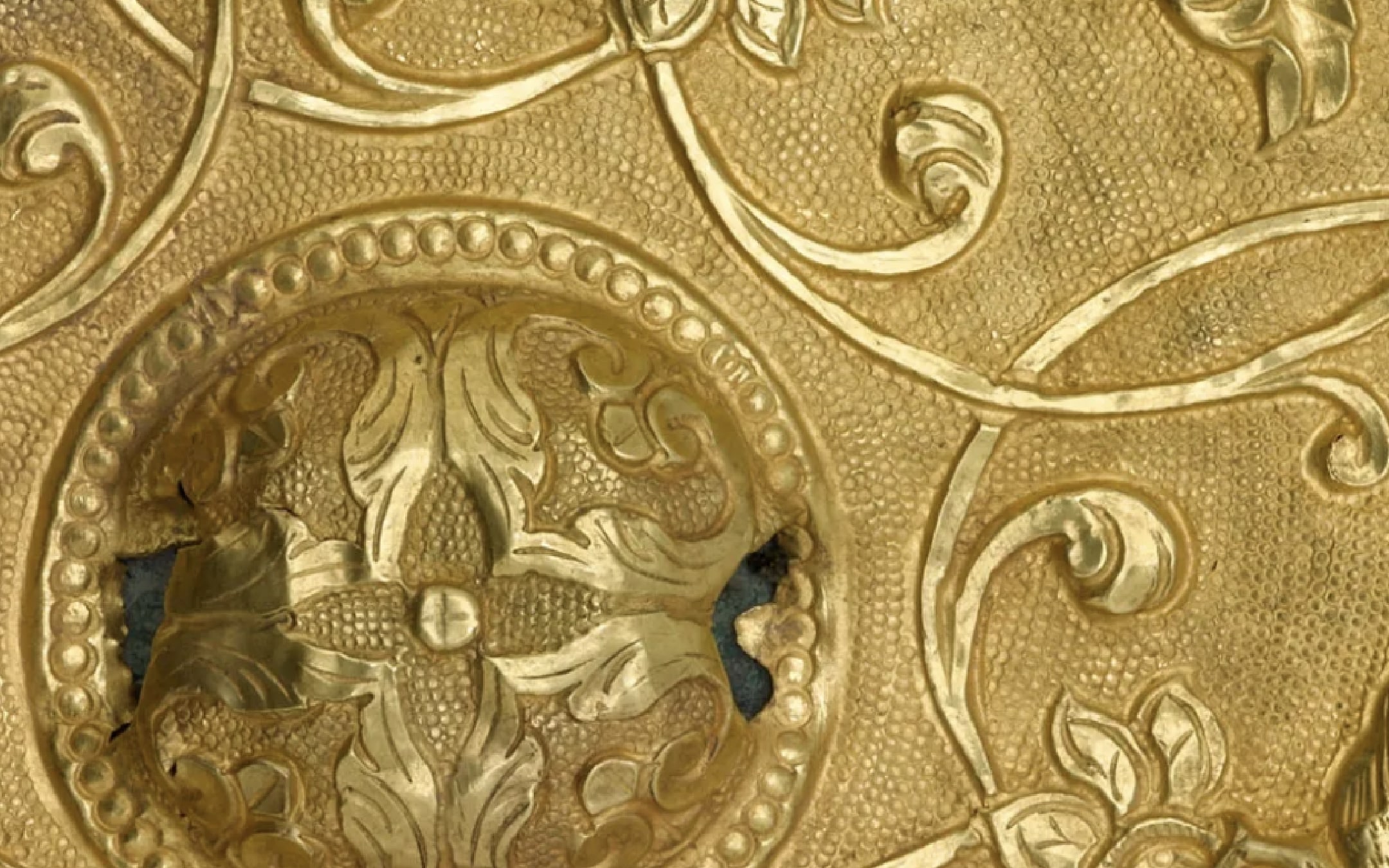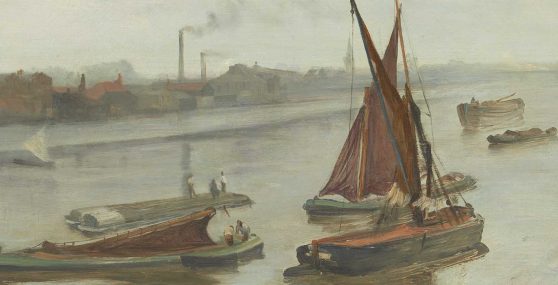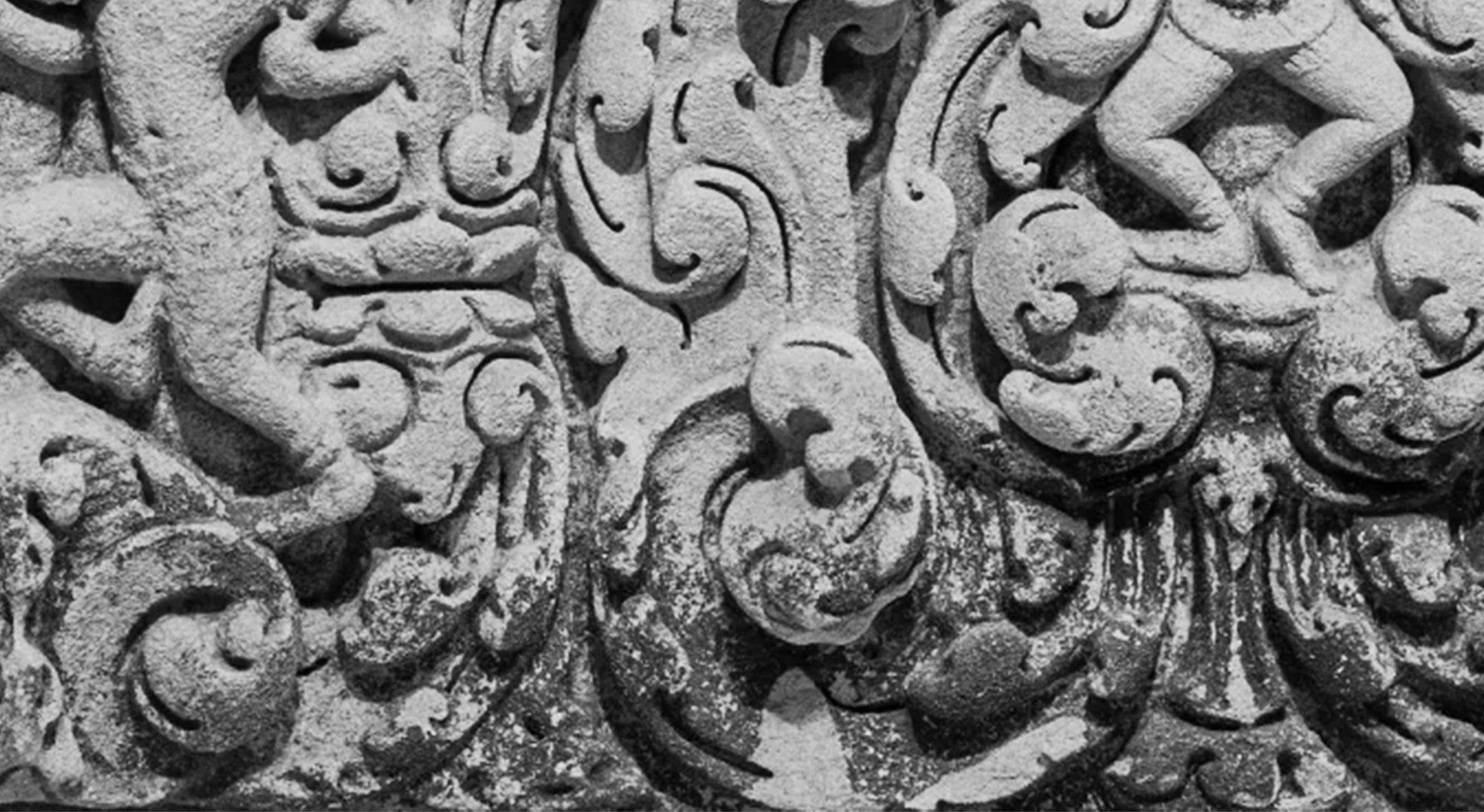May 3–August 17, 2014
-
Dates
-
Location
Arthur M. Sackler Gallery
-
Collection Area
American Art
James McNeill Whistler occupies a pivotal position between cultures and artistic traditions of East and West. American-born, French-trained, and London-based, he was an artist with a truly cosmopolitan background. Born in Lowell, Massachusetts, in 1834, he grew up in the United States, England, and Russia. He studied briefly at the United States Military Academy at West Point, learned to etch at the US Coast and Geodetic Survey in Washington, D.C., and left to study art in Paris in 1855. Four years later he settled in London, where he hoped to attract patrons among the growing number of wealthy merchants and shipping magnates in that city. He worked along the docks, etching and painting the bridges, old and new, that spanned the river Thames. He depicted the workers and prostitutes, sailors and stevedores, the decaying wharves, the ferries and wherries, and clippers and cutters. Whistler documented the industrial and commercial center of the greatest port in Europe in all its dirty, crowded, bustling activity.
Living within sight of the river, Whistler recorded the changes wrought by industrialization: changing vistas, new landmarks, even the dense atmosphere of smog mingled with gaslight. Over the years his subject matter, techniques, and compositions evolved with his sites. He sought to convey the essence of the river—the lifeblood of the city—ebbing and flowing before his perceptive eyes and caught by his skillful brush. In the 1870s, after a period of self-imposed artistic re-education that included close study of Japanese woodblock prints, Whistler’s style became more atmospheric, his colors more limited, and his point of view less descriptive. Along with a series of powerful, impressionistic oils and the nearly abstract Nocturnes, Whistler made sketches in pencil and chalk, watercolors with expressive brushwork and delicate coloring, richly textured lithographs and lithotints, and finely detailed etchings and drypoints that showed his masterly draftsmanship. In the Sackler Gallery’s first international loan exhibition of art by Whistler, more than eighty works bring to vivid life the city, the Thames, and the people of Victorian London.
An American in London: Whistler and the Thames has been organized by the Addison Gallery of American Art, the Dulwich Picture Gallery, London, and the Arthur M. Sackler Gallery, Smithsonian Institution. Exhibition support is generously provided by the Mr. and Mrs. Raymond J. Horowitz Foundation for the Arts and the Friends of the Freer and Sackler Galleries. Additional support for programming is provided by the Terra Foundation for American Art.
Press
-
“These late Whistlers are widely adored not just as radical innovations in representation, but as entirely successful and satisfying visual idylls.”
— Philip Kennicott, The Washington Post -
"In this show's most mysterious pictures...Whistler, himself a force of nature, brings the storm indoors." — Lance Esplund, The Wall Street Journal
-
"[This] exhibition illustrates the challenge of painting mist and moving water." — The Economist
Video
James McNeill Whistler’s connection with London and his enduring fascination with the Thames are explored in this brief video. Learn more about this intriguing expatriate American artist, the development of his art, and his association with museum founder Charles Lang Freer.

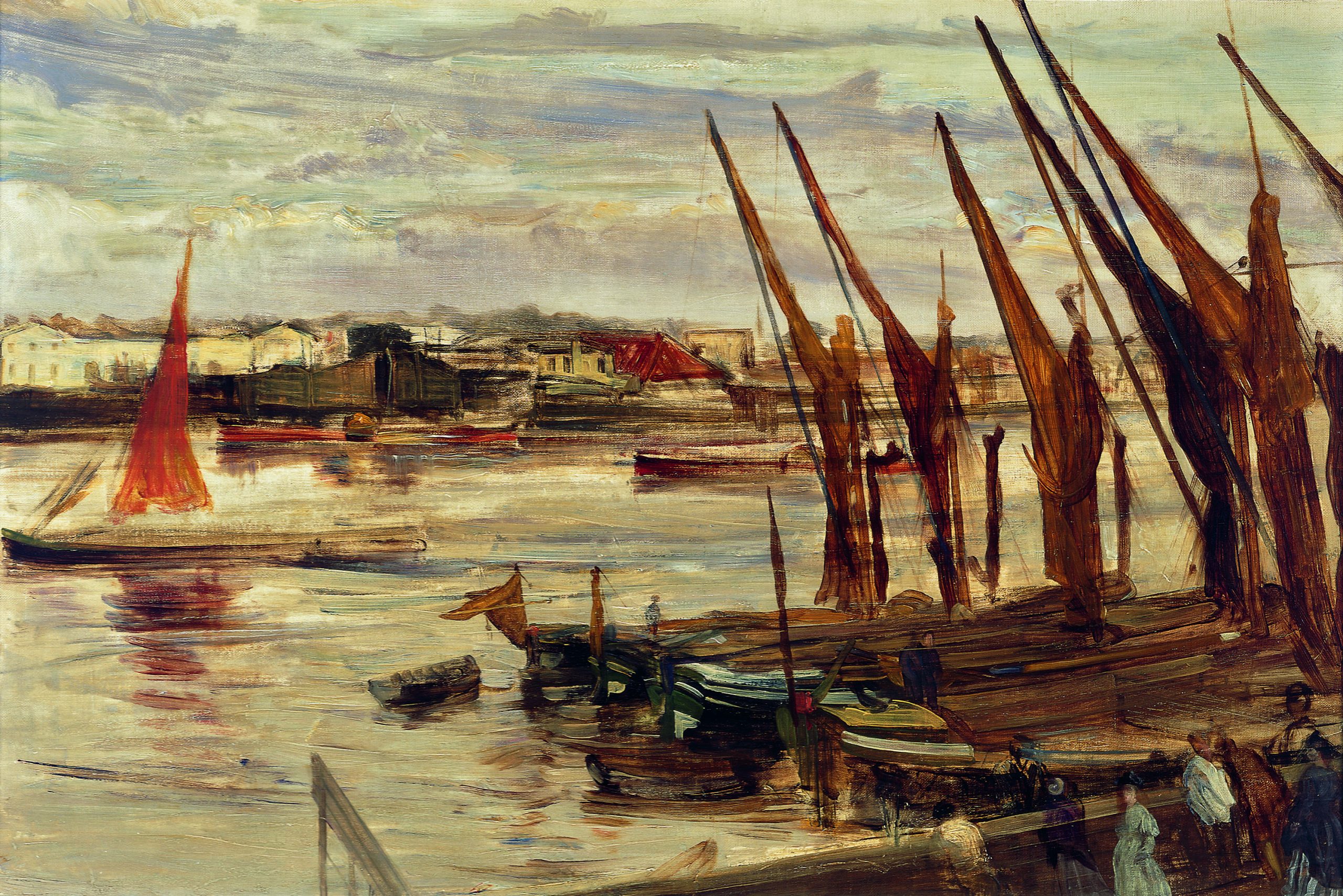
Battersea Reach
Whistler described this painting of “a view of the opposite bank of the river, from out of my window, on a brilliant autumn evening” as a “gorgeous bit of color” and “a favorite of mine.” He recalled creating it “in one go,” and it is indeed painted thinly, with the exception of the vigorous brushwork on the boats in the foreground. The asymmetrical composition, in which the lone red sail in the middle ground visually balances the graceful array of masts on the right, suggests Whistler’s growing fascination with Japanese art.
ca. 1863
Oil on canvas
Corcoran Gallery of Art, Washington, D.C.
Image 1 of 11
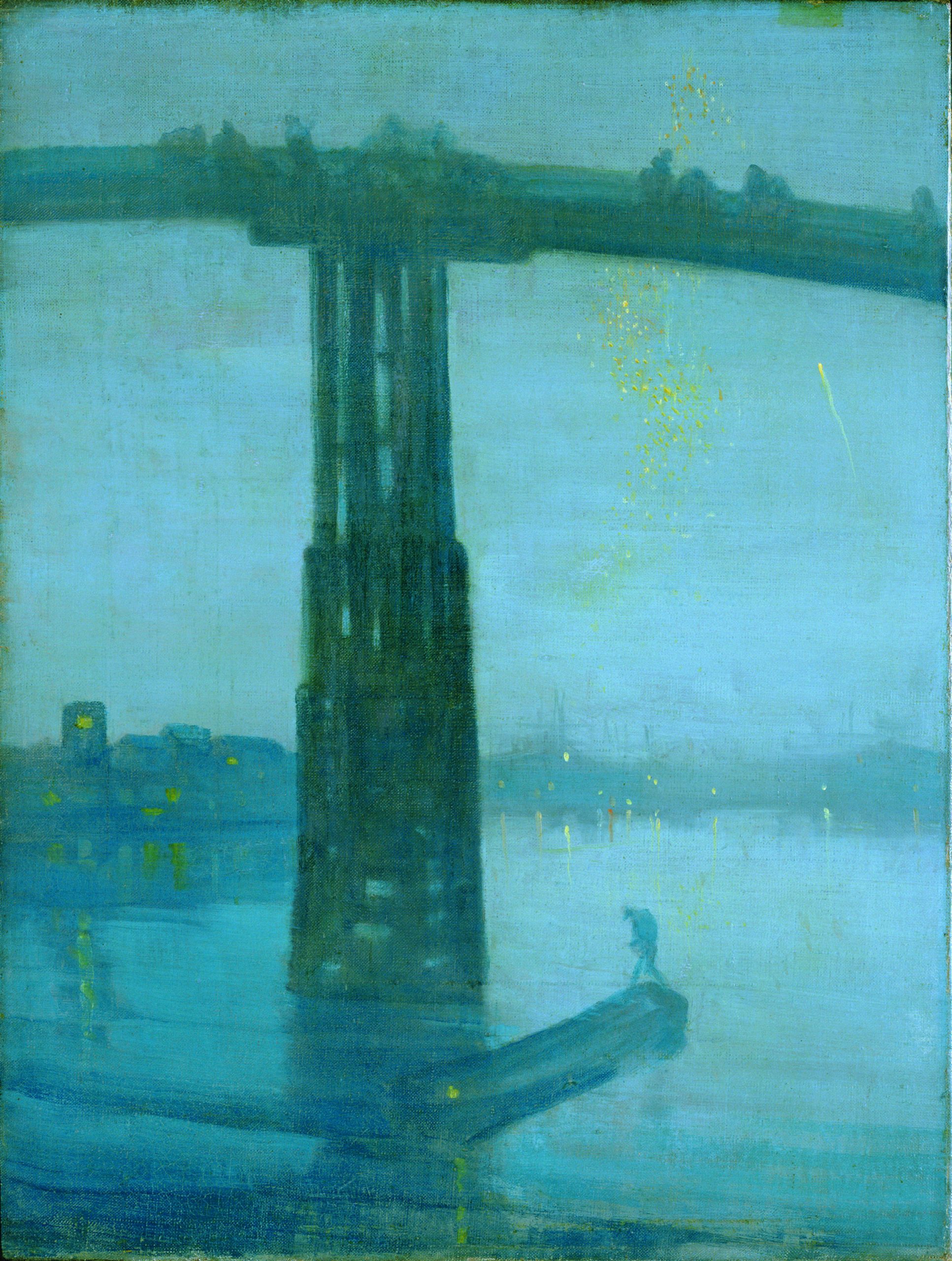
Nocturne: Blue and Gold—Old Battersea Bridge
When Whistler sued the prominent art critic John Ruskin for libel in 1878, Nocturne: Blue and Gold was brought forth as evidence for the defense, which claimed the painting was “just as comprehensible turned upside down.” This poeticized vision of Battersea Bridge contrasts strongly with Whistler’s realistic representations from the early 1860s. The composition, dominated by the structure of the bridge, relates closely to his interest in Japanese woodcuts, such as Hiroshige’s series Famous Views of the Sixty-odd Provinces. The outlines of the bridge were painted thinly, while the fireworks, lights, and reflections were added later with thicker paint. Albert Bridge, completed in 1873, is barely discernible in the background dimness.
1872–73
Oil on canvas
Tate Britian, London
Image 2 of 11
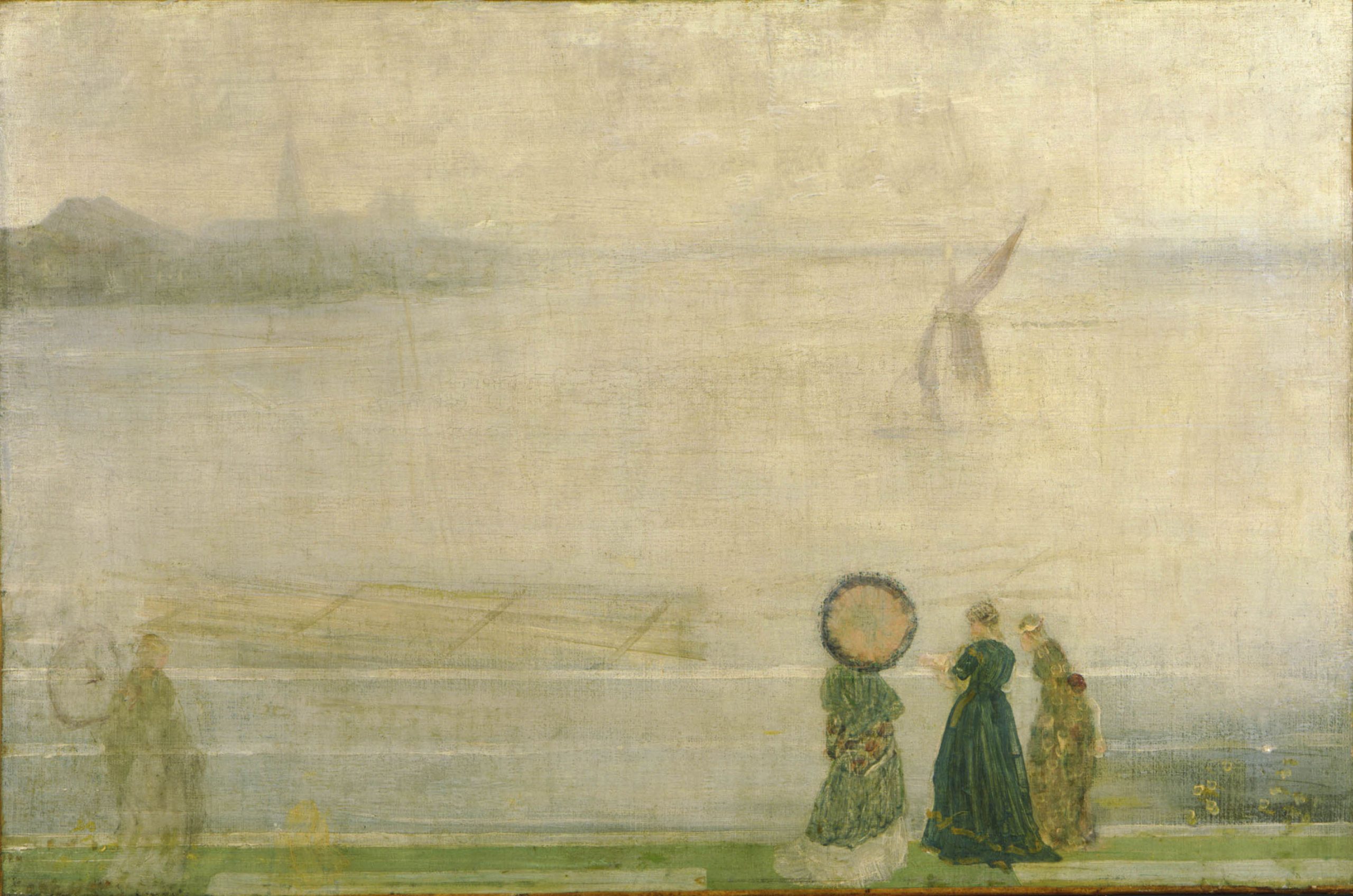
Battersea Reach from Lindsey Houses
Seen from Whistler’s house in what is now Cheyne Walk in Chelsea, the women on the right wear brightly colored dresses that were fashionable around 1870. They are placed on top of earlier figures clad in semiclassical gowns in pastel colors. The two faint figures on the left are similar to the robed models that Whistler painted in the late 1860s in a series known as the Six Projects (now on view in the Freer Gallery of Art). Signs of repainting are also evident on the river, particularly where a sailing barge has been partially erased.
ca. 1864
Oil on canvas
The Hunterian, University of Glasgow
Image 3 of 11
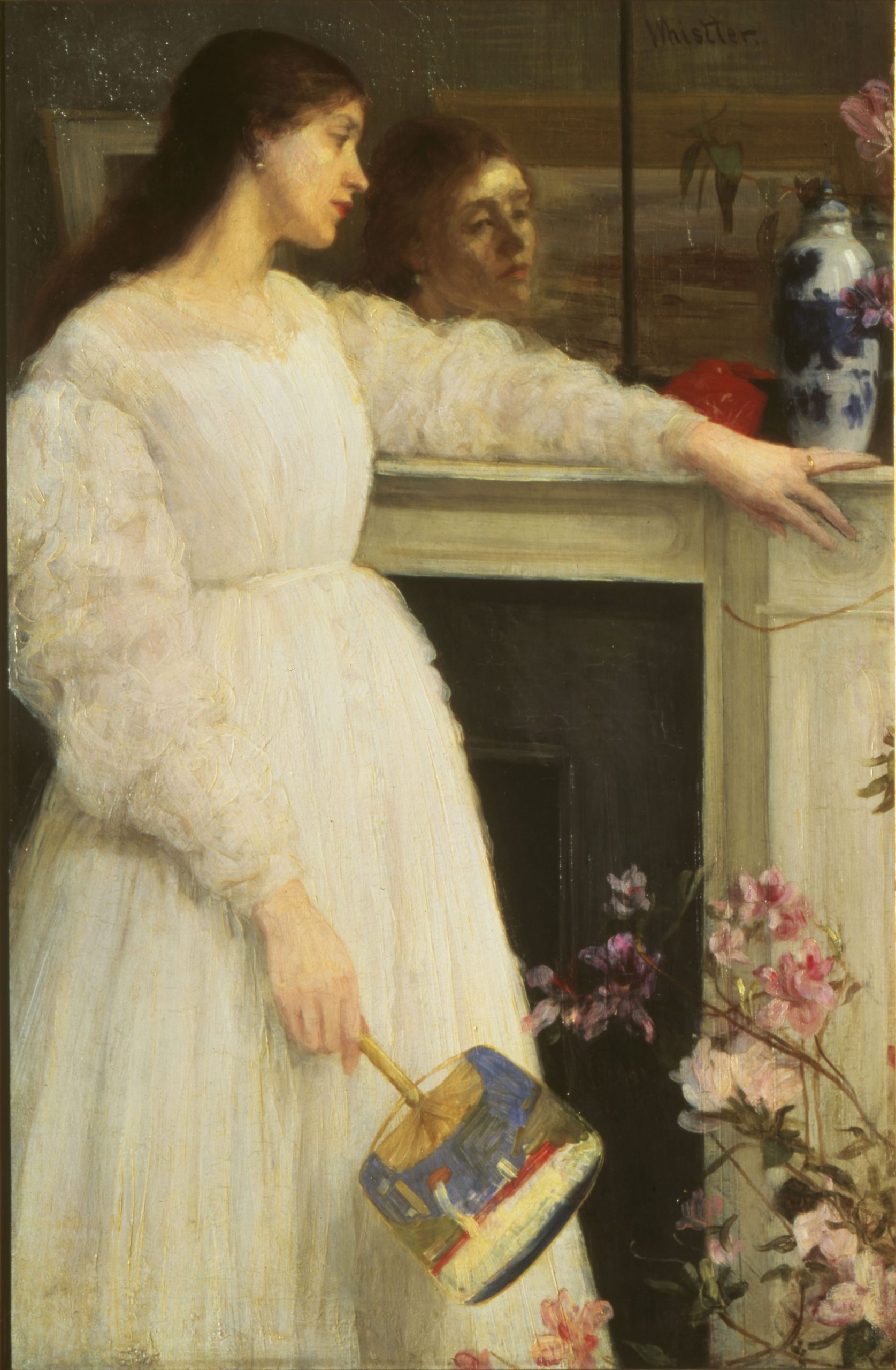
Symphony in White No. 2: The Little White Girl
Japanese fans decorated Whistler’s Lindsey Row drawing room, which overlooked the banks of the Thames, and they appear as props in several works from the mid-1860s. This portrait of Joanna Hiffernan is set in the artist’s dining room, where the décor included pink azaleas and Chinese porcelain. The model, wearing an uncorseted yet fashionable muslin gown, holds a fan decorated by Hiroshige with a view of a famous Edo site: the banks of the Sumida River.
1864
Oil on canvas
Tate Britain, London
Image 4 of 11

Black Lion Wharf
This is the only example among the Thames Set in which Whistler reversed the image on the etching plate to ensure the final print reads as a true depiction of the view. Black Lion Wharf was located between Downes and Carron wharves, east of Saint Katharine’s Dock. Whistler includes signboards for several wharves in the area, thus enhancing the topographically specific quality of the scene. He also placed a framed impression of this etching in the background of the work for which he is best known: Arrangement in Grey and Black: Portrait of the Painter’s Mother.
1859
Etching and drypoint
Bequest of Mr. Samuel E. Stokes, Jr.
FSC-GR-619
Image 5 of 11
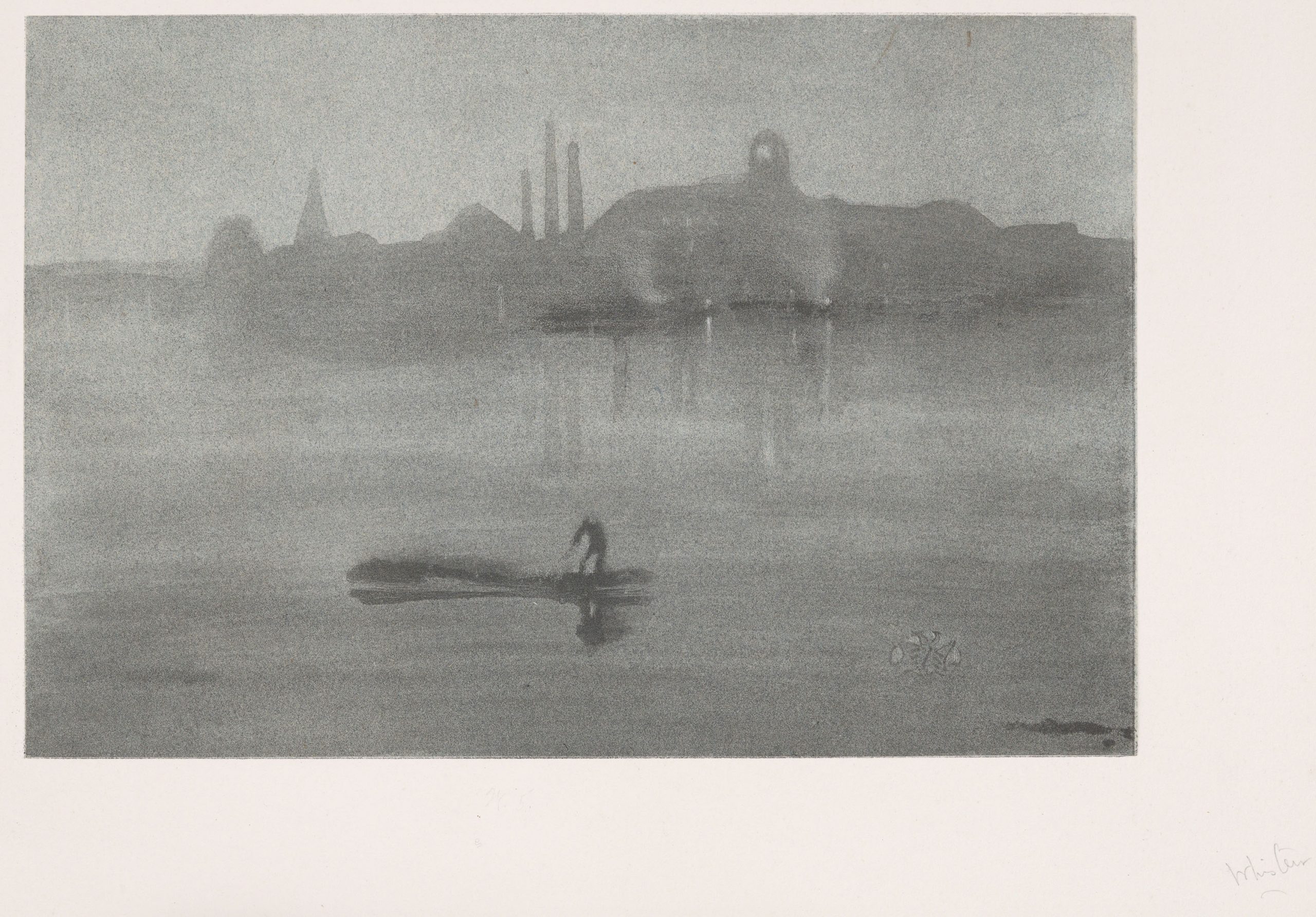
Nocturne
According to the printer T. R. Way Jr., Whistler created this lithotint “at one sitting from memory.” It captures the view of the Battersea shore from Chelsea that the artist had seen, drawn, and painted so often after he moved to Lindsey Row.
1878
Lithotint on blue paper
F1905.208
Image 6 of 11
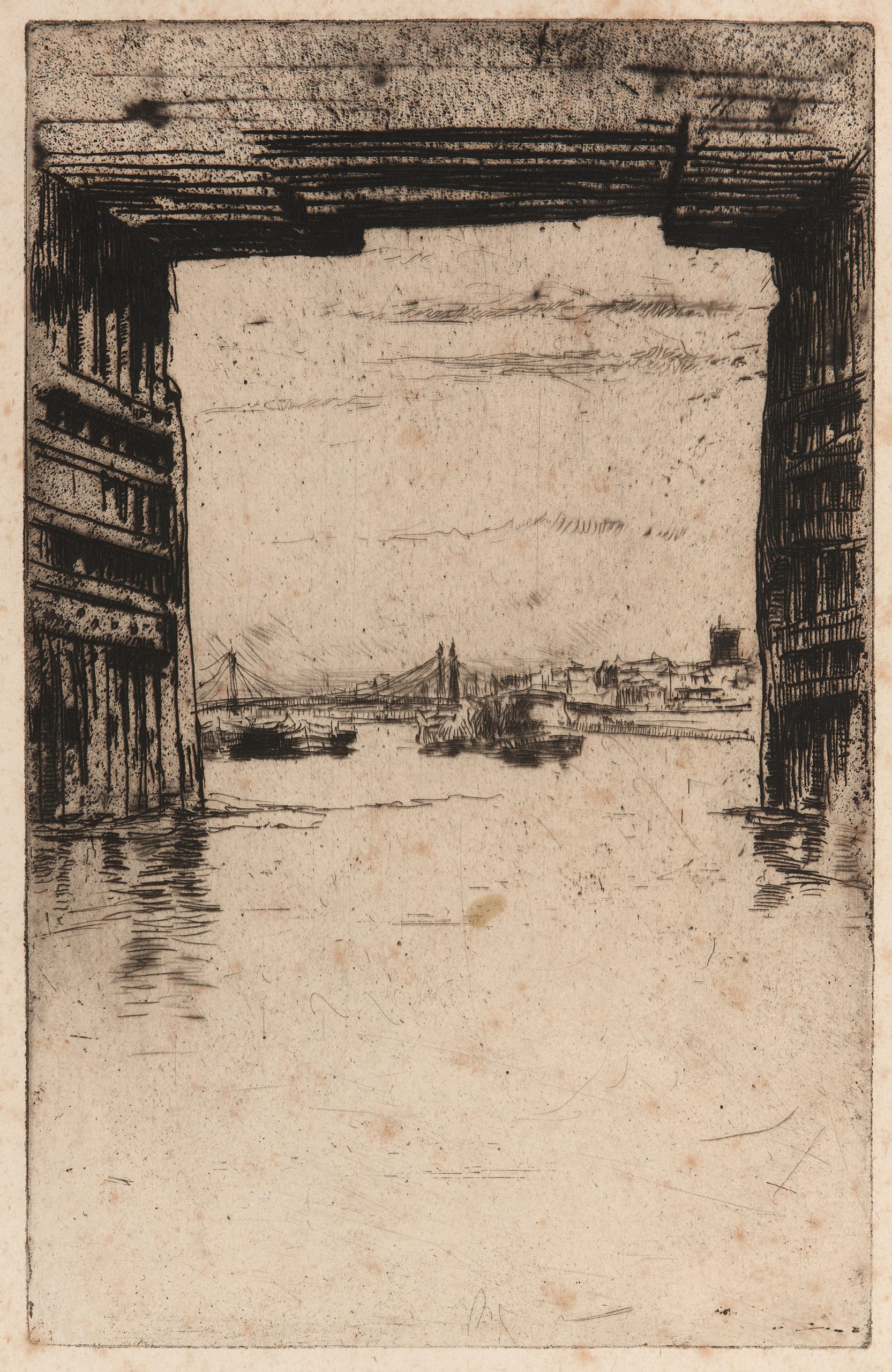
Under Old Battersea Bridge
This etching shows the two piers to the left of the central passage under old Battersea Bridge. The Chelsea Suspension Bridge is visible in the distance on the left (the view was reversed in printing). An “open bite” technique—applying or “painting” acid directly on the plate—was used to produce the richly textured dark mass of the bridge. Drypoint shading added soft atmospheric effects in the background.
1879
Etching and drypoint
F1904.93
Image 7 of 11
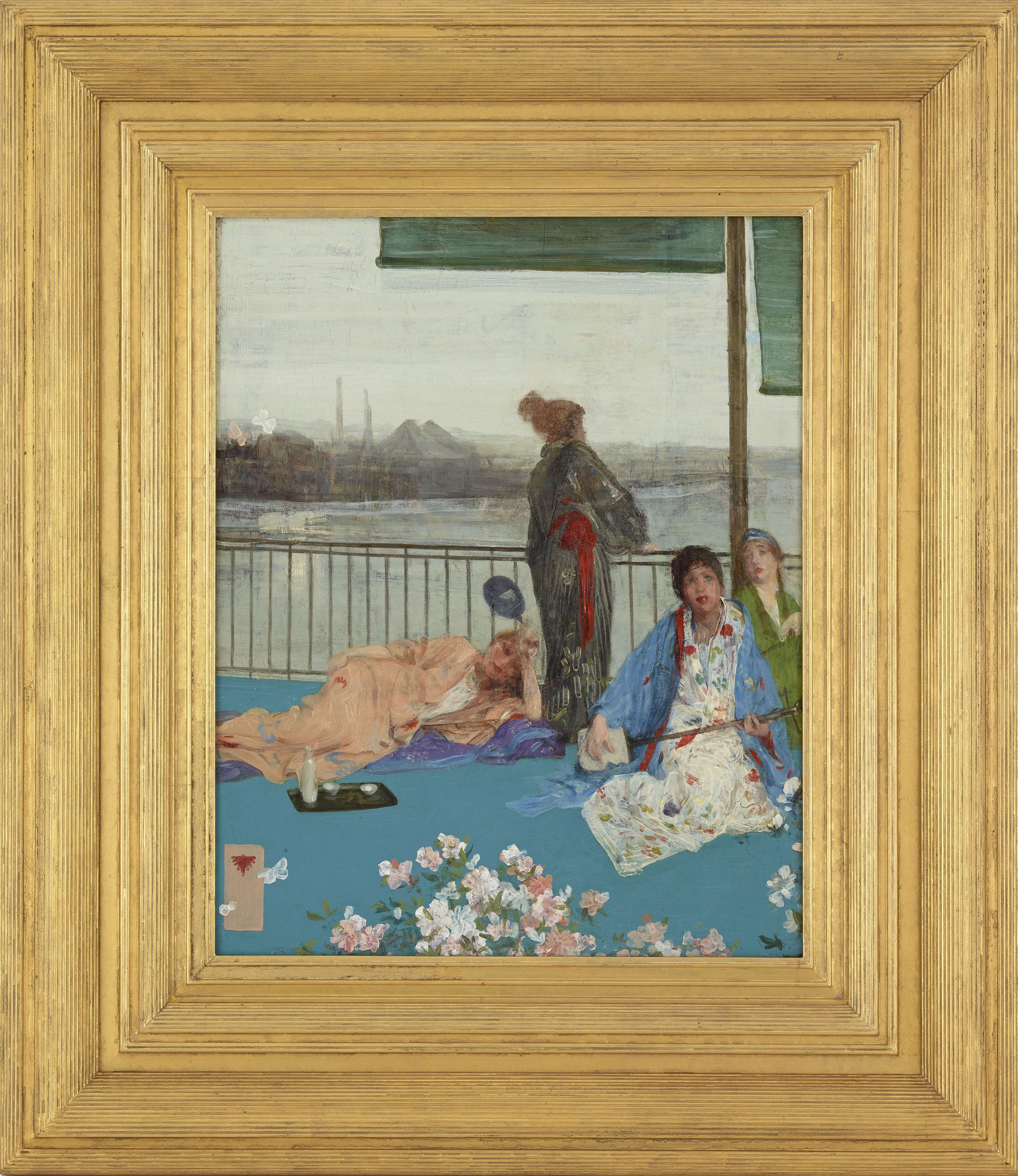
Variations in Flesh Colour and Green: The Balcony
English models dressed in kimonos pose before the view outside Whistler’s studio in Lindsey Row, Chelsea. The bright, flatly painted foreground and East Asian props suggest a world far from industrial London, yet the standing figure looks out at the same vista that Whistler depicted—far less fancifully—in Brown and Silver: Old Battersea Bridge.
Most painters would have overlooked these factories, but Whistler chose to transform the modern cityscape through the visual language of art. The smokestacks are veiled in atmospheric mist, and the adjacent slag heap (a monument of industrial waste) evokes images of Mount Fuji by Japanese artists Utagawa Hiroshige and Katsushika Hokusai. Butterflies, a symbol of metamorphosis, link the foreground fantasy to the real world beyond the balcony. Beginning with this painting, Whistler signed his work with a butterfly instead of his name, thereby linking himself and London to visions of Japan.
1864–70
Oil on wood panel
F1892.23
Image 8 of 11
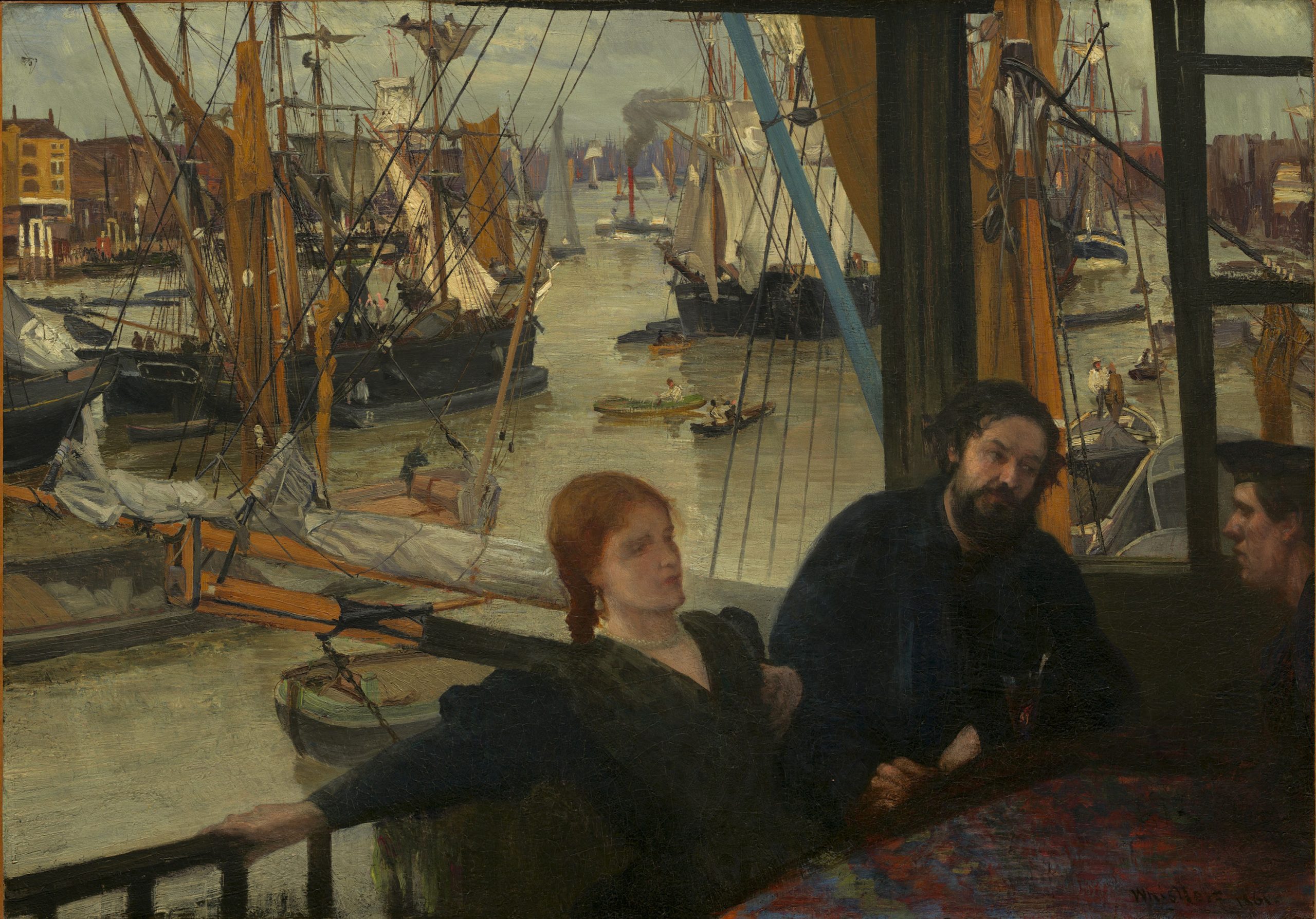
Wapping
Wapping was painted from the balcony of the Angel, a public house that still stands along the Thames. The composition gave Whistler trouble: over the years he altered, repositioned, and replaced figures and repainted the scene both on site and in his Chelsea studio at Lindsey Row. Whistler’s model, his red-haired Irish mistress Joanna Hiffernan, was originally depicted as a sailor’s “molly,” but she was repainted to assume a more modest and reflective persona before Wapping was displayed at the Royal Academy in 1864.
Writing to his friend, artist Henri Fantin-Latour, in 1861, Whistler confided he was working on a painting “which I am absolutely certain must become a masterpiece.”
It is on a balcony right above the Thames. There are three people—an old man in a white shirt the one in the middle who is looking out of the window—then on the right in the corner, a sailor in a cap and a blue shirt with a big collar turned back in a lighter blue, who is chatting to a girl who is jolly difficult to paint!… Now through the window you can see the whole Thames! The background is like an etching—and was unbelievably difficult!… And just by the head of the girl (who I forgot to tell you looks supremely whore-like) there is the bowsprit of another large boat, the ropes and pulleys of which go across the whole picture.… There are also many small boats and buildings which I cannot put into the sketch. But my dear Fantin I assure you that I have never attempted such a difficult subject.
1860–64
Oil on canvas
National Gallery of Art, Washington
Image 9 of 11
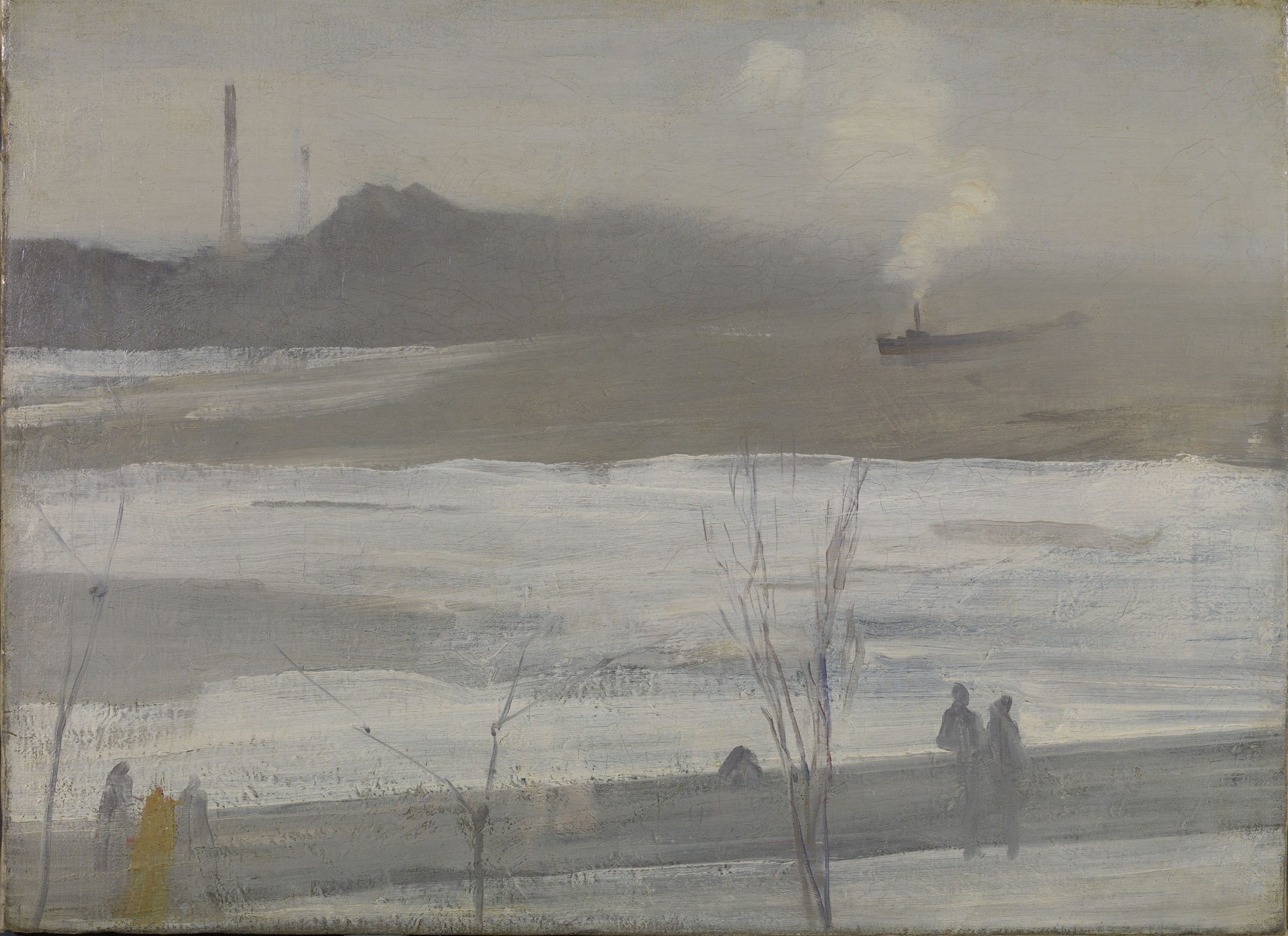
Chelsea in Ice
During a particularly cold February, Whistler painted this view of the Chelsea shore from his house, looking across to the Battersea factories in the distance. The artist’s mother reported he “could not resist painting while I was shivering—at the open window.”
1864
Oil on canvas
Colby College Museum of Art, Waterville, Maine
Image 10 of 11

Brown and Silver: Old Battersea Bridge
Begun in 1859, this painting is Whistler’s earliest depiction of Old Battersea Bridge, which became a recurrent motif in his work. Here, London’s last surviving wooden bridge, not yet slated for demolition, crosses the river to the factories of Battersea on the opposite side. The Crystal Palace, constructed to house the Great Exhibition of 1851, is visible on the distant horizon.
When Whistler exhibited Brown and Silver at the Royal Academy in 1865, critics praised its realistic rendering of the “English grey and damp.” Much later, while on a lengthy sojourn in Venice, Whistler claimed the English fogs as his own: “They are lovely those fogs—and I am their painter!” The canvas embodies Whistler’s close connection to the Thames as an artistic subject. Beneath the thinly painted surface hides the ghost of an earlier work: a self-portrait of the artist.
1859–63
Oil on canvas
Addison Gallery of American Art, Phillips Academy, Andover, Massachusetts
Image 11 of 11
Map
As London became a modern city in the late nineteenth century, its population surged, and industry and commerce altered the look and feel of streets and neighborhoods. Entire areas were torn down and rebuilt. Familiar landmarks and views were altered—or they disappeared altogether—as factories, bridges, and housing blocks rose in their place. Photographers and artists responded to these changes, often showing the unsettling juxtaposition of old and new.
Use this 1853 map to view London in the nineteenth century. Each pin approximates Whistler’s vantage point or the location of a photograph of the city.
Unless otherwise noted, all of these works are by James McNeill Whistler. They are the Gift of Charles Lang Freer and are now in the collection of the Freer Gallery of Art.
Keep Exploring
-

Kiyochika: Master of the Night
March 29, 2014–July 27, 2014
Detail, Grey and Silver–Old Battersea Reach, by James McNeill Whistler. Oil on canvas, 1863. The Art Institute of Chicago.
- Jump To...

